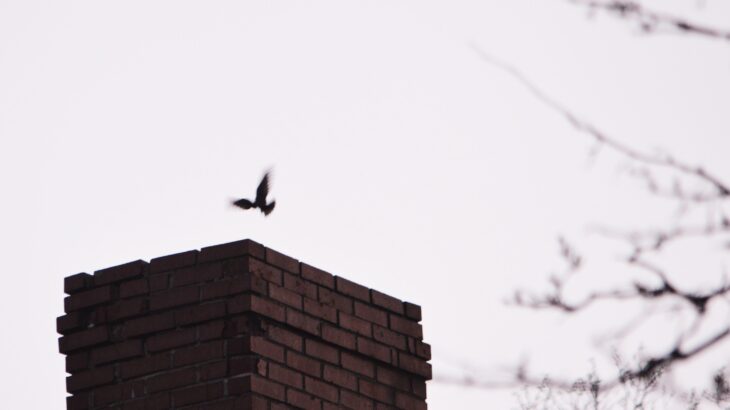By Catherine Dale, Managing Editor
Tracking how human influences are changing the natural world is a common goal of science. However, to determine how something is changing, you need to know what it looked like in the past – and often, no records exist. To fill this gap, scientists sometimes turn to unconventional sources of data to reconstruct history.
Part 1: Waste not, want not
In 2009, Chris Grooms, a research technician in the Queen’s University Biology Department, and Dr. Joe Nocera, a post doc, read an old paper about a chimney swift roost on campus. Realizing they had never seen swifts using the chimney of Flemming Hall, they went to investigate. They thought it would be a quick look-and-see mission. Instead, they wound up working with an interdisciplinary team of scientists on a groundbreaking study exploring bird population declines – all because of the two metre deep pile of bird guano they found at the bottom of the chimney.
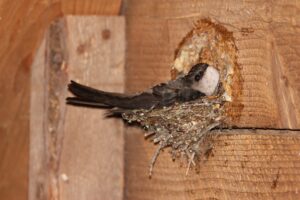
Chimney swifts are small aerial insectivores which spend almost their entire lives in the air. When not flying, they cling to vertical surfaces, even gluing their nests to these surfaces using their sticky saliva. Photo by Allison Manthorne, used with permission.
The guano was the byproduct of the chimney’s decades of use as a communal roost by chimney swifts. Chimney swifts are members of a group of birds called aerial insectivores, which all catch and eat flying insects on the wing. Swifts spend virtually their entire lives in the air; when they do land, their long claws make it impossible to perch like most birds. Instead, they cling to vertical surfaces, such as the inside of hollow trees, cave walls, and chimneys.
In the spring and fall, chimney swifts gather in communal roosts. Birds that are not breeding will continue to use these roosts throughout the summer. From the time it ceased to be an active chimney in 1928 until it was closed off with mesh in 1992, the chimney of Flemming Hall was home to thousands of chimney swifts every year.
Grooms and Nocera wondered: if the swifts were given access again, would they return to the chimney? “We were hoping for a feel-good conservation story,” says Nocera, now a professor at the University of New Brunswick. Queen’s agreed to let the biologists remove the mesh, on one condition: they were responsible for cleaning up the mess the swifts made. And this is how they found themselves eyeing up two metres of bird poop.
The scoop in the poop
Even biologists need a good reason to go through a pile of poop. Here is what led Nocera and Grooms to go through all two metres of their pile, one painstaking centimetre at a time.
Aerial insectivores are undergoing some of the most dramatic population declines of all Canadian birds, and chimney swifts are among the hardest hit. Their population has declined by an estimated 67% across their range over the last 50 years, and in 2009, the species was listed as Threatened under Canada’s Species at Risk Act.
There are several possible culprits for declines in aerial insectivores, and in many cases multiple factors may be acting in concert. However, as all aerial insectivores share the same general diet and foraging behaviour, decreases in insect numbers are likely playing a role, and may be forcing birds to change their diets. Unfortunately, long-term data on chimney swift diets does not exist, making it difficult to determine whether their diets have changed over time. The discovery of the pile of poop at the bottom of the Flemming Hall chimney offered a unique opportunity to change that.
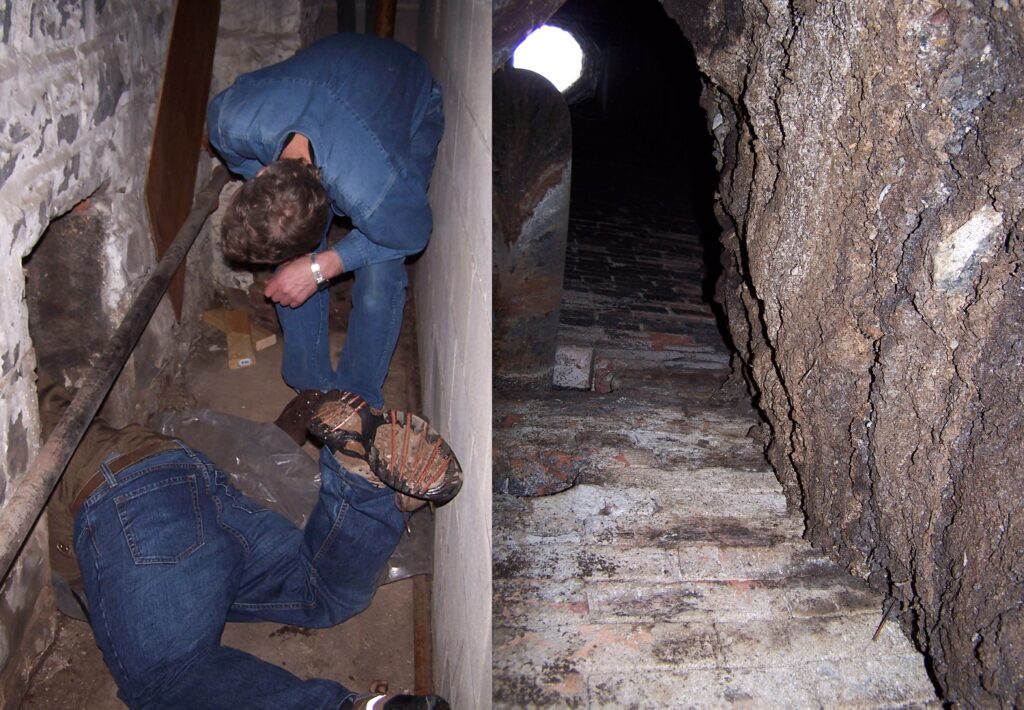
Left: To access the chimney, the researchers crawled through a (very) small door at the bottom. Right: Once inside, they were confronted with this two-metre-high pile of guano. Photos by Chris Grooms, used with permission.
While Nocera was focused on the logistics of cleaning up the chimney, Grooms was thinking like a paleolimnologist. Paleolimnologists study the physical, chemical, and biological properties of sediments that accumulate at the bottom of lakes to reconstruct past environments. Grooms wondered if similar methods might be employed on the guano.
At first Nocera was skeptical, thinking the pile was mostly rubble. But when he got a sample under a microscope, he realized it consisted almost entirely of indigestible insect remains. In fact, 99% of the material in the pile had been produced by the swifts.
“That’s when I said to Chris, ‘I think we have something here’,” he recalls.
Digging through the pile
When Nocera and Grooms realized the pile of guano was composed largely of insect remains deposited by the swifts year after year, they decided to apply a paleolimnological approach: taking samples from the layers in the pile to see if and how its composition changed over time.
To start, the researchers needed to determine a timeline for the samples. They knew the top layer of the pile was deposited in 1992, the year the chimney was closed off. The bottom layer of the pile dated from the first year the chimney was home to a swift colony – 1928. But they needed a third reference point.
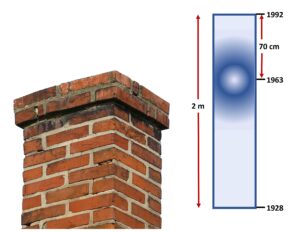
To date the guano samples, the researchers used the amount of Cesium-137 (represented here in blue), a radioactive isotope which peaked in 1963. They discovered the guano had accumulated at approximately 2.2 cm per year. Graphic created by Catherine Dale.
To determine this point, they used a method common in paleolimnology: measuring the amount of Cesium-137 in the guano samples. Cs137 is a radioactive isotope produced during above-ground nuclear tests conducted between the 1940s and 60s. Atmospheric levels of Cs137 peaked in 1963, then decreased after the Nuclear Test-Ban Treaty was signed that year.
Examination of the guano samples revealed Cs137 levels peaked 70 cm from the top. Based on the reference timepoints, the researchers determined that the guano had accumulated at a rate of approximately 2.2 cm per year.
The next step was to determine the composition of the guano layers. Samples from each year were divided into multiple subsamples. Nocera worked with one set of subsamples to identify insect remains under the microscope. He quantified the proportion of beetles (species belonging to the order Coleoptera) and so-called ‘true bugs’ (species belonging to the order Hemiptera).
Another set of subsamples was sent to the University of Ottawa, where environmental toxicologist Dr. Jules Blais analyzed them to determine the concentration of the insecticide DDT, which was used heavily in North America from the 1940s until it was banned across the continent in the 1970s and 80s.
A swift change
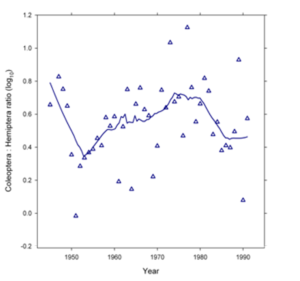
The proportion of beetles (Coleoptera) to true bugs (Hemiptera) in the swift guano dropped sharply in the late 1940s and early 1950s before increasing again. Graph created by Joe Nocera, used with permission.
Their results suggested that chimney swifts dramatically changed their diet between the 1940s and 1950s: the proportion of beetles in the guano decreased sharply, while the proportion of true bugs increased. At the same time as the proportion of beetles dropped, the levels of DDT peaked.
The researchers theorized that the widespread use of DDT in the 1940s and early 50s may have caused a collapse in beetle populations, as beetles are more susceptible to the effects of the chemical than other insects. Faced with a sudden shortage of beetles, swifts were forced to use another food source. However, this new food source was lower quality – beetles are more energy-rich than true bugs – and so the switch in diet may have led to declines in the swift population.
The researchers had no way to determine how many swifts used the roost each year, so could not say if the dietary shift affected the number of swifts. They also found that the swifts’ diet shifted back towards its original proportion of beetles after that dip in the 1950s, so a lack of beetles does not explain continuing declines in swift populations.
But Nocera says the dietary shift detected in the guano has important lessons to teach us because it may provide insight into the drivers of aerial insectivore decline today.
“There are two main hypotheses for current population declines,” he explains. “They could be a result of decreases in insect populations, or they could be due to habitat loss. Looking at the historical dietary record provided by the guano is a way to discover how sensitive aerial insectivore populations were to variations in insect availability in the past. Then we can look at the current changes in bird populations and make better inferences about what’s causing them.”
In other words, we need to understand the past to understand the present – and in the case of chimney swifts, a large pile of poop provided an unexpected opportunity to do just that.
Look for the second installment of this two-part series highlighting creative approaches Canadian scientists have used to extract long-term data about environmental changes, coming next month.
Banner image: A single chimney swift hovers over a roost chimney. Photo by Allison Manthorne, used with permission.

